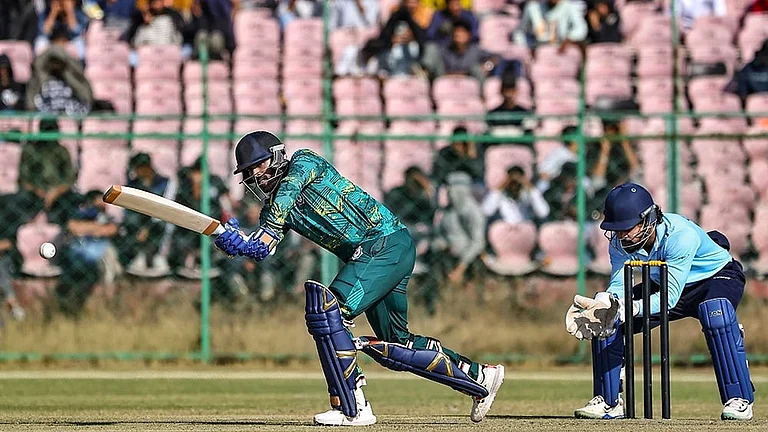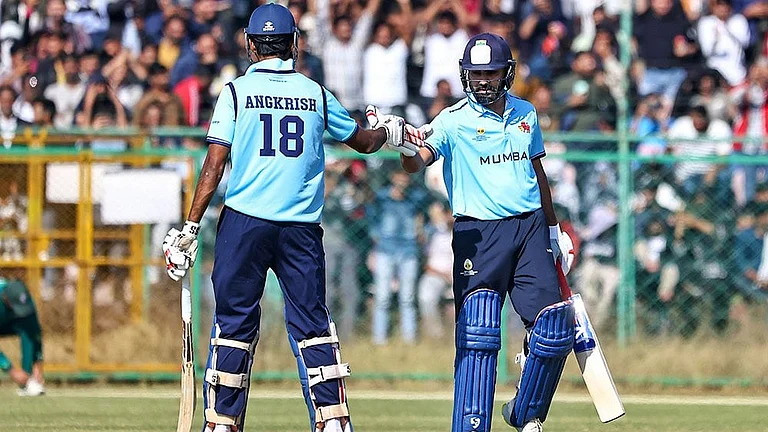Nimble fingers pass a string of silk through a warp of vertical threads, tying intricate knots and often comb-beating them to a tight finish. The weaver varies the colours of the weft to create figurative images, occasionally glancing over the talim—a piece of paper, the blueprint of motifs and layout decided before the loom was strung at the kharkhana.
The routine continues for at least five months, kind of like a gestation until the child is born. The outcome of this labour of love: the handmade Kashmiri silk carpet, around Rs 87,000 apiece. Their beauty, of course, is priceless.
However, the 700-year-old Kashmiri carpet industry, which remained largely unaffected by the insurgency scarring the Valley since 1989, is spinning into decline because of the international economic crisis. In the turbulent 1990s, when the Valley faced large-scale crackdowns and shutdowns, the artisans wove carpets, embroidered pashminas and handpainted papier mache boxes in their homes. Exports brought good money. The industry grew.
At the peak of its business, with a clientele spread over Europe, the US and West Asia, there were around 100,000 weavers in nearly 30,000 handlooms creating expensive silk and fine Cashmere carpets. But over the past four years, business nosedived. Many weavers were retrenched; some wouldn’t get salaries for months on end. Some began working as construction labourers to make ends meet.

Weavers at a kharkhana in Srinagar
Today, in a gloomy room of an old house at Bagwanpora in the old city neighbourhood of Srinagar, two tired artisans are weaving a carpet. No one is sure if it will ever get a buyer. “The business is over. There is no profit,” says one of the weavers, Gulzar Ahmad Bhat. The owner of loom, 45-year-old Nazir Ahmad Dar, agrees. “He is right.”
Bhat, a resident of the Eidgah area of Srinagar, joined his brother, an artisan, in the 1990s. He gradually learned the art and flourished, until the global financial crisis struck. Bhat’s brother now works as a mason. “He took a wise decision. My earnings are stuck at Rs 200 a day from 10 hours of work. I will also leave soon,” he says.
The Dars were famous for their assembly of looms—100 until a decade ago across Srinagar, employing more than 500 weavers. Now they are down to only one loom and three workers. “When I set up this business, I believed it would be good, but now I regret it,” says Dar, who graduated in commerce from the University of Kashmir in 1997.
“I was mad about carpets and wanted to become a manufacturer known for high-quality ones,” he says. As every household in the area had a loom, weaving was dignified work. Dar says he would sell carpets to business houses in the Valley, which would export it to Russia and other European countries. Businessmen came from different parts of the country to take the handmade carpets from Dar. In 2008, when recession hit the US, many friends from Delhi told Dar to switch to some other career. But Dar believed the Kashmiri carpet would survive, as it has for 700 years.

An intricately-designed carpet in Srinagar
“I was wrong. People don’t have the money anymore for carpets. There are no buyers,” Dar says. He points to a broken door of the house, pasted with papers bearing names and addresses of people from the Valley and outside. “They owe me money. They have taken carpets from me. I forget their names. So I keep the list on the door and occasionally ring them up,” he says. “This is the wanted list,” he laughs, finding humour amid the pain and anxiety.
Dar has four daughters and his dream for them is not the family business. “My eldest daughter is doing her postgraduation. I wish she gets a government job and has a secure life,” he says.
In a four-storey house in the same locality, 27-year-old Ruveed-ul-Islam is more interested in social work than his carpet business—a family heirloom from grandfather Abdul Khaliq Dar. Ruveed joined his father, Ghulam Nabi Dar, at age 12 and learned the art’s finer points. Later, he infused innovations into the business. He brought iron looms capable of making bigger carpets. These are now lying discarded on the lawns of his house. Some are being used for the iron gate of his home. Over 250 artisans have left the firm.
A pile of carpets are kept at the central hall of the house. Dar shows 30-foot-long carpets, costing between Rs 25 lakh and Rs 30 lakh. “I have Rs 5 crore worth of carpets in my house. There are no buyers,” says the man who had spent nights on the internet to find customers, but to no avail.
Around eight years ago, Ruveed’s firm GN Carpets had a turnover of Rs 5 crore to Rs 10 crore a year. But the slump has taken its toll. He is now left with just memories of the good times. “I have sold carpets in Palestine as well,” he says proudly. “My carpets are handmade and knotted. They were much in demand. I have been to Dubai and have exported carpets in large numbers.”
His father, G.N. Dar, blames machine-made carpets manufactured in places like Budaun in Uttar Pradesh and Amritsar in Punjab for the decline in the Kashmiri carpet’s clientele. He says the irony is these are sold in the Valley by Kashmiri salesmen as genuine handmade carpets. “Whatever little market we had in the Valley was taken over by the machine-made carpets,” he laments.
Ruveed calls for tougher measures to stop people from selling machine-made ripoffs at tourist places in Kashmir as handmade carpets. “That will sustain the industry to some extent, helping the artisans and the manufacturers. Otherwise, the artisans and the famous Kashmiri handmade knotted carpet will soon see their end,” he says.
The Valley—with its mountains dotted with rolling meadows, gushing streams and beautiful lakes—has been a popular tourist destination and visitors often picked up carpets as souvenirs. Tourism has been the mainstay of the people’s economy for long, until the insurgency erupted and enmeshed the picture-postcard landscape into an unrelenting turmoil. Few tourists visit these days because of fear as well as the economic situation. And hence, sales to foreigners and high-end domestic tourists have dropped significantly.
At his home in the upmarket Rajbagh area of Srinagar, Mohamed Sadiq Wani, owner of the popular Suffering Moses showroom in Lal Chowk, understands the pessimism of the artisans. He is hopeful that the Kashmiri carpet will survive if big-spending tourists start visiting the Valley again. “When foreigners visit here, they appreciate the quality of Kashmiri carpets. They admire it and at times place huge orders. Kashmiri manufacturers should maintain the quality when exporting in bulk and that is the challenge,” he advises.
Wani’s family history is intrinsically linked to Kashmiri carpets and handicrafts. His ancestors came to Kashmir from Persia (modern-day Iran) in the 13th century, around the time when Sufi philosopher Hazrat Mir Syed Ali Hamdani came to the Valley along the silk route with his disciples and brought with him highly skilled artisans. The Persian art that came with the holy man, also known as Shah-e-Hamdan, flourished in the Valley and carved its own niche identity: the Kashmiri carpet. Wani says the Kashmiri carpet is a replica of Persian carpets in their knotting, dyes, design and detail.
History also plays a part in the showroom’s name—Suffering Moses, which opened in 1840. “This biblical name was given to our showroom by a British lord during my great grandfather’s time,” Wani says. The name stuck and the Wanis are one of Srinagar’s oldest and most respected handicraft families. They were among the first in the Valley to export carpets to the US.
Wani also blames machine-made, cheap copies of the Kashmiri carpet flooding the market for the homespun industry’s decline in the Valley. “People seldom look minutely,” he says.
Ashiq says the carpet industry is an unorganised sector and the government has not intervened proactively for its promotion. “We forwarded a proposal to the previous government to create an infrastructure within a village. That will ensure work for the artisans and supply of high-quality carpets. We told the government that the American market is to be explored,” says Ashiq, adding that Kashmiris were exporting majorly to the trouble-hit West Asia where wars, like the one in Syria, have pulled the plug on the market.
He says the former PDP-BJP government had allocated support money for the carpet industry. But the initiative was lost after the coalition government fell. He believes aggressive marketing in western countries, especially the US, can rescue the industry. “We have no threat from carpets made in Amritsar, Jaipur and so on. They are machine-made, synthetic carpets. Ours are silk carpets that last longer and there are buyers for them,” he says.
But gloom has set in. Manzoor Ahmad Wangnoo’s National Cottage Emporium and Kashmir Mahal showroom at Delhi’s Maurya Sheraton has Hillary Rodham Clinton as its celeb client since her first visit in 1995. She has been regular whenever she visits the city. The Clintons were fascinated by the quality at his shop. “The Kashmiri carpet’s fineness lures people. We did good business. Not anymore,” says Wangnoo.
There was a time when he had the luxury of picking the finest of carpets from hundreds sent to him every day. “Today I wait for one carpet. The global recession has affected us badly,” Wangnoo says. Amidst the handful of poor weavers, hunched over wooden looms weaving the intricate knots of carpets and weary of thinking ways to save their families from hunger, Ruveed reads the signs: “Kashmir’s carpet industry is going through an existential crisis. It will not come out of it.” Won’t it?
By Naseer Ganai in Srinagar


























